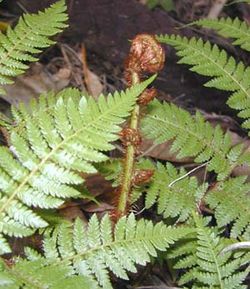Polypodiopsida
| Pteridopsida ~ Fieitos modernos | |||||||
|---|---|---|---|---|---|---|---|
 Fieito | |||||||
| Clasificación científica | |||||||
| |||||||
| Ordes | |||||||
| |||||||
Polypodiposida é unha clase de plantas da División Pteridophyta (fieitos) que inclúe todos os fieitos leptosporanxiados. Antes chamada Pteridopsida, na recente clasificación feita no 2006 por Smith et al. a clase é renomeada a Polypodiposida. Este nome recente de fieitos Monilophyta baséase en estudos moleculares publicados desde 1994 que clarificaron algunhas das confusións na clasificación e relacións entre as familias de fieitos.[1] Polypodiopsida é unha das catro clases de Monilophytes (unha Infradivisión, esta clasificación non é recoñecida polo International Code of Botanical Nomenclature), as outras tres son Marattiopsida, Equisetopsida, e Psilotopsida.[1]
Clasificación
[editar | editar a fonte]O esquema de clasificación proposto por Smith et al.(nomes alternativos entre parénteses):
- Orde Osmundales
- Familia Osmundaceae
- Orde Hymenophyllales
- Familia Hymenophyllaceae (incl. Trichomanaceae)
- Orde Gleicheniales
- Familia Gleicheniaceae (incl. Dicranopteridaceae, Stromatopteridaceae)
- Familia Dipteridaceae (incl. Cheiropleuriaceae)
- Familia Matoniaceae
- Orde Schizaeales
- Familia Lygodiaceae
- Familia Anemiaceae (incl. Mohriaceae)
- Familia Schizaeaceae
- Orde Salviniales
- Familia Marsileaceae (incl. Pilulariaceae)
- Familia Salviniaceae (incl. Azollaceae)
- Orde Cyatheales
- Familia Thyrsopteridaceae
- Familia Loxomataceae
- Familia Culcitaceae
- Familia Plagiogyriaceae
- Familia Cibotiaceae
- Familia Cyatheaceae (incl. Alsophilaceae, Hymenophyllopsidaceae)
- Familia Dicksoniaceae (incl. Lophosoriaceae)
- Familia Metaxyaceae
- Orde Polypodiales
- Familia Lindsaeaceae (incl. Cystodiaceae, Lonchitidaceae)
- Familia Saccolomataceae
- Familia Dennstaedtiaceae (incl. Hypolepidaceae, Monachosoraceae, Pteridiaceae)
- Familia Pteridaceae (incl. Acrostichaceae, Actiniopteridaceae, Adiantaceae, Anopteraceae, Antrophyaceae, Ceratopteridaceae, Cheilanthaceae, Cryptogrammaceae, Hemionitidaceae, Negripteridaceae, Parkeriaceae, Platyzomataceae, Sinopteridaceae, Taenitidaceae, Vittariaceae)
- Familia Aspleniaceae
- Familia Thelypteridaceae
- Familia Woodsiaceae (incl. Athyriaceae, Cystopteridaceae)
- Familia Blechnaceae (incl. Stenochlaenaceae)
- Familia Onocleaceae
- Familia Dryopteridaceae (incl. Aspidiaceae, Bolbitidaceae, Elaphoglossaceae, Hypodematiaceae, Peranemataceae)
- Familia Lomariopsidaceae (incl. Nephrolepidaceae)
- Familia Tectariaceae
- Familia Oleandraceae
- Familia Davalliaceae
- Familia Polypodiaceae (incl. Drynariaceae, Grammitidaceae, Gymnogrammitidaceae, Loxogrammaceae, Platyceriaceae, Pleurisoriopsidaceae)
Discusión da Clasificación Molecular
[editar | editar a fonte]Houbo algunha oposición aos recentes estudos moleculares, avisando que ofrecen unha visión sesgada das ordes filoxenéticas porque os estudos non teñen en conta fósiles representativos [2]. De calquera xeito, os estudos moleculares aclararon relacións entre familias que foron cridas como non monofiléticas antes da información molecular, as cales foron deixadas en clasificacións non monofiléticas porque non se tiña información abondo para facer o contrario [3]. A reclasificación dos fieitos empregando múltiples estudos moleculares, os cales se apoian entre si, non é diferente entre clasificacións do pasado.
Notas
[editar | editar a fonte]- ↑ 1,0 1,1 Smith, A. R., K. M. Pryer, et al. (2006). "A classification for extant ferns." Taxon 55(3): 705-731
- ↑ Rothwell, G. W. and K. C. Nixon (2006). "How does the inclusion of fossil data change our conclusions about the phylogenetic history of euphyllophytes." Int. J. Plant Sci 167(3): 737-749
- ↑ Kramer, K. U. (1990). Notes on the Higher Level Classification of the Recent Ferns. The Families and Genera of Vascular Plants: Pteridophytes and Gymnosperms. K. Kubitzki, K. U. Kramer and P. S. Green. New York, Springer-Verlag. 1: 49-52
| Wikispecies posúe unha páxina sobre: Polypodiopsida |
Text is available under the CC BY-SA 4.0 license; additional terms may apply.
Images, videos and audio are available under their respective licenses.
